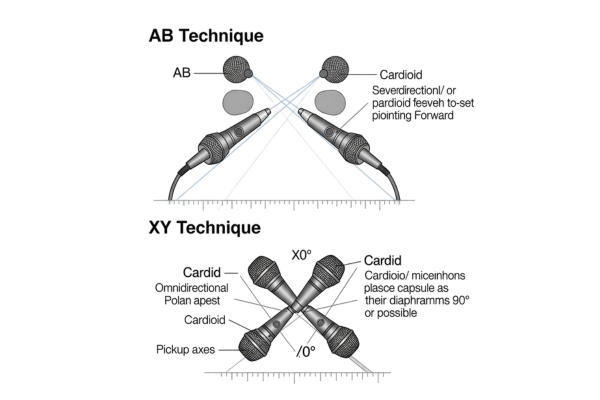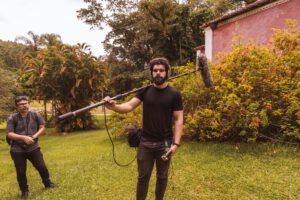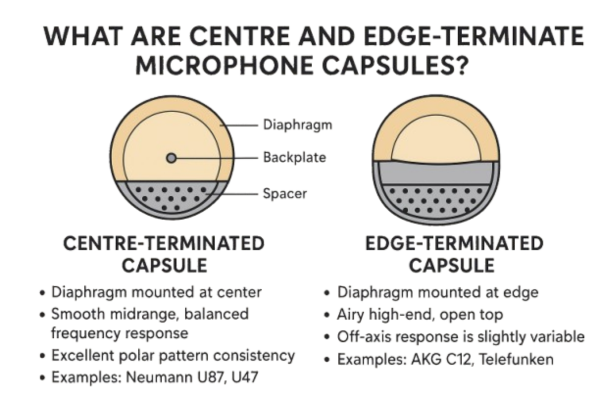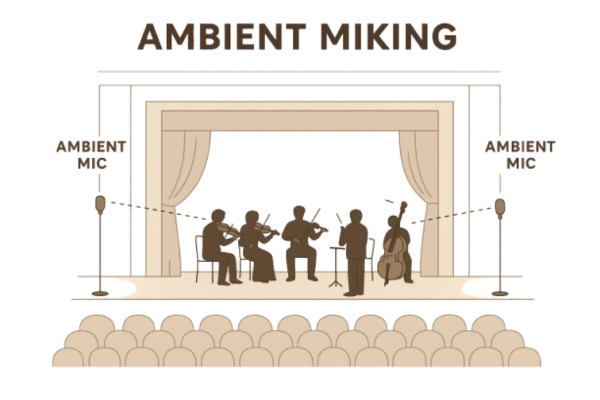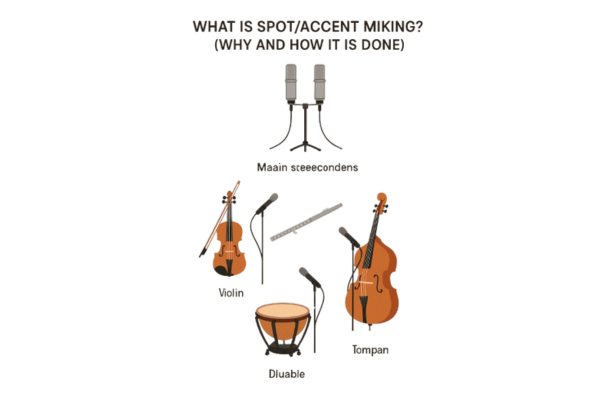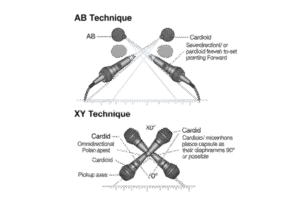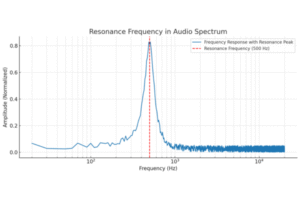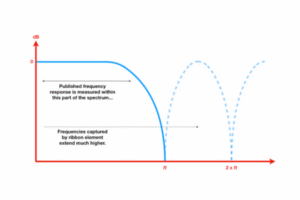When recording music or soundscapes, microphone placement plays a crucial role in capturing the spatial depth, stereo image, and tonal balance of the source. Two of the most widely used stereo microphone techniques are AB (spaced pair) and XY (coincident pair). Both methods aim to create a natural stereo field, but they achieve this in very different ways.
Microphone placement is a critical skill for any recording engineer, as it significantly impacts the final sound of a recording. The choice of technique can define the stereo image, sense of space, and overall tonal balance. Two of the most common stereo microphone techniques are AB and XY. Understanding the differences between these two can help you make a more informed decision for your next recording session. Let’s elaborate the same
Table of Contents
AB Technique Microphone Placement
The AB technique (Spaced Pair) involves placing two identical microphones a certain distance apart—often between 17 cm to 1 meter depending on the recording situation. The mics are typically positioned parallel to each other, pointing toward the sound source.
The AB technique, also known as Spaced Pair, uses two omnidirectional or cardioid microphones placed parallel to each other at a distance. The distance between the microphones is the key variable, typically ranging from a few inches to several feet, depending on the sound source and desired effect. A common starting point is around 17 cm (6.7 inches), which mimics the average distance between human ears, giving a natural stereo perspective.
The stereo image in AB is created by the time difference of arrival of sound waves at each microphone. Because the microphones are spaced apart, a sound source on the left will reach the left microphone slightly before it reaches the right one. This time delay, called Interaural Time Difference (ITD), is what our brains use to localize sound, and it creates a wide, spacious, and often dramatic stereo image.
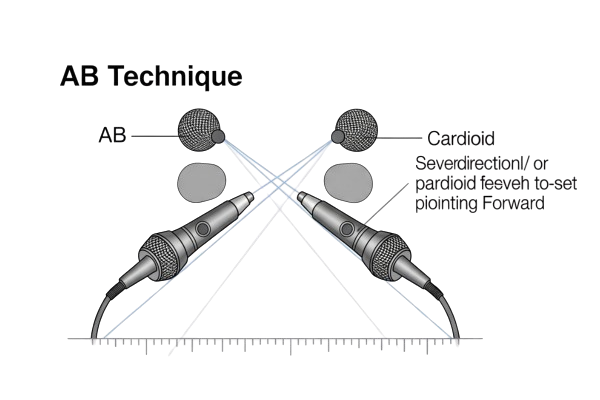
How Spaced Pair AB Techniques Works
When to use AB Microphone Placement Techniques
Advantages of AB Microphone Placement Techniques
Challenges AB Microphone Placement Techniques
How Spaced Pair AB Techniques Works
The stereo image is created primarily through time-of-arrival differences (phase differences) between the two microphones. The wider the spacing, the greater the sense of stereo width and depth
When to use AB Microphone Placement Techniques
For capturing a sense of space: AB is excellent for recording ensembles, orchestras, and choirs where you want to capture the ambiance and natural reverb of the room.
For a wide stereo image: It creates a very broad stereo field, making it ideal for instruments that spread across the soundstage, like a piano or a large drum kit overhead.
For bass-heavy instruments: Omnidirectional microphones used in AB have a flat frequency response down to the lowest frequencies without the proximity effect, making them a great choice for instruments like pipe organs or grand pianos.
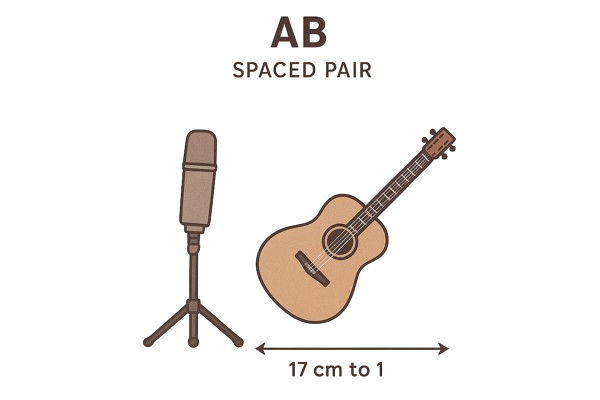
Advantages of AB Microphone Placement Techniques
Creates a wide, spacious stereo image.
Captures the natural acoustics of the recording environment.
Great for orchestras, choirs, and ambient recordings.
Challenges AB Microphone Placement Techniques
Can introduce phase issues when summed to mono. Requires careful mic spacing to avoid comb filtering
The XY Technique Microphone Placement
The XY technique (Coincident Pair) places two cardioid microphones with their capsules as close as possible, usually at an angle of 90° to 135°. This positioning makes both microphones coincident at one point.
The XY technique, or Coincident Pair, uses two directional microphones (usually cardioid) with their capsules placed as close as possible to each other, typically with a 90-degree angle between them. The microphones are angled outwards to face the left and right sides of the sound source.

How Coincident Pair XY Techniques Works
When to a use XY Microphone Placement Techniques
Advantages of XY Microphone Placement Techniques
Challenges of XY Microphone Placement Techniques
How Coincident Pair XY Techniques Works
The stereo effect comes from level (amplitude) differences, not timing.
Since capsules are aligned, there is virtually no phase cancellation. Unlike AB, the stereo image in XY is created by the intensity difference of the sound waves. Because the capsules are so close, there is no significant time difference between the arrival of a sound at each microphone. Instead, a sound source on the left will be picked up more loudly by the left-facing microphone and softer by the right-facing one, a phenomenon known as Interaural Level Difference (ILD).
When to a use XY Microphone Placement Techniques
For a precise stereo image: XY provides a very stable and sharp stereo image with excellent mono compatibility. Since there’s no time difference, phasing issues are virtually eliminated.
For a focused sound: It’s great for close-miking individual instruments where you want a clear, well-defined stereo spread without a lot of room sound. Examples include acoustic guitar or solo strings.
For broadcast or live sound: The excellent mono compatibility makes XY a reliable choice for situations where the stereo signal might be summed to mono, as is common in radio broadcasts or live sound reinforcement.
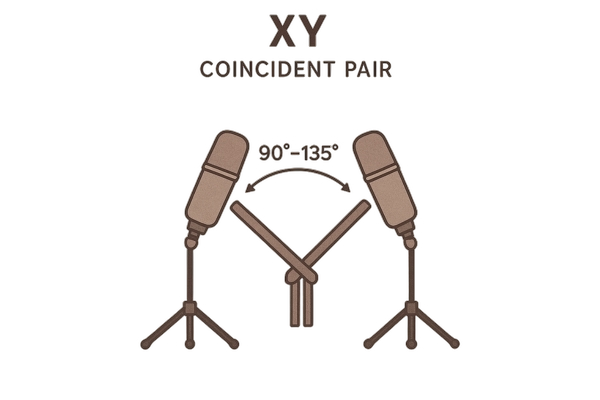
Advantages of XY Microphone Placement Techniques
Excellent mono compatibility (no phase problems).
Produces a tight, focused stereo image. Ideal for close-miked instruments, drum overheads, and smaller ensembles.
Challenges of XY Microphone Placement Techniques
The stereo image is narrower compared to AB.
A Simple Comparision Between AB Spaced pair and XY Coincident Pair
| Feature | AB (Spaced Pair) | XY (Coincident Pair) |
| Microphone Type | Omnidirectional or Cardioid | Directional (Cardioid) |
| Stereo Imaging | Wide and Spacious | Stable and Focused |
| Mechanism | Time Difference (ITD) | Intensity Difference (ILD) |
| Mono Compatibility | Can have Phase Issues | Excellent, no Phase Issues |
| Common Use | Orchestras, Room Miking | Solo Instruments, Drum Overheads |
| Sense of Space | High, captures more room | Low, captures less room |
Practical Tips for Recording
Use AB when you want to capture the natural acoustics of a hall or ensemble performance.
Use XY when recording in smaller spaces or when mono compatibility is critical.
Experiment with microphone distance and angles—small adjustments can drastically change the recording. Always check your mix in mono playback to ensure phase consistency.
Capturing Natural Dialogue: AB vs. XY Microphone Placement
That’s a great, focused angle especially since AB and XY aren’t only for music but are widely used in film, TV, and podcast dialogue recording. Here are some polished title options around your idea
Capturing clear, natural-sounding dialogue is one of the most important tasks in film, television, podcasting, and voice-over production. While shotgun and lavalier microphones are often the first choice for dialogue, stereo microphone techniques like AB (spaced pair) and XY (coincident pair) can add realism, depth, and spatial dimension to conversations. Let’s explore how these techniques apply specifically to dialogue recording.
The AB Technique for Dialogue
The AB technique uses two microphones spaced apart (typically 17 cm to 1 meter), pointed toward the speakers.
How It Works in Dialogue Recording
Stereo width is created through time differences between when each mic receives the sound. When recording dialogue between two or more people, AB can capture not just the voices but also the room ambience and placement of speakers.

Advantages of AB Microphone Placement Techniques
Creates a wide, immersive stereo image that feels natural in a room.
Useful for roundtable discussions, interviews, or group dialogue scenes.
Adds a sense of environment, making the dialogue feel “in place.”
Challenges of AB Microphone Placement Techniques
Phase issues may occur if the recording is folded down to mono (common in broadcast or film post-production).
Can pick up unwanted room reflections, making it less suitable in untreated spaces.
The XY Technique for Dialogue
In the XY setup, two cardioid microphones are placed with their capsules almost touching, angled at 90° to 135°.
How It Works in Dialogue Recording
Stereo imaging comes from level differences instead of timing.
Since the mics are coincident, there are no phase issues—a big advantage in post-production.
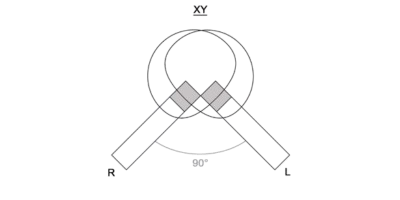
Advantages XY Microphone Placement Techniques
Excellent mono compatibility (important for film, TV, and podcasting).
Produces a focused, realistic stereo image of dialogue.
Great for two-person interviews, podcasts, or dialogue scenes where clarity is key.
Challenges XY Microphone Placement Techniques
The stereo image is narrower than AB.
Doesn’t capture much room ambience, which can make recordings sound “drier.”
AB vs XY in Dialogue Recording
| Feature | AB Technique (Spaced Pair) | XY Technique (Coincident Pair) |
| Stereo Image | Wide, spacious | Narrow, focused |
| Phase Issues (Mono) | Possible | Minimal to none |
| Room Ambience | Captures more | Captures less |
| Best For | Group dialogue, naturalistic scenes | Two-person dialogue, podcasts, broadcast |
Practical Tips for Using AB & XY with Dialogue
For film sets: XY is often safer because of its mono compatibility. AB may be used for wide ambient dialogue or group chatter in a scene.
For interviews/podcasts: AB works well when you want a sense of “space” between speakers; XY is better for clarity when publishing to multiple platforms.
Check in mono: Always test your recording in mono, since many playback systems (TVs, radios, phones) collapse stereo tracks.
Mind the room: AB captures more of the room’s sound—great if the space sounds good, problematic if it doesn’t.
Conclusion
Dialogue Recording
Both AB and XY microphone techniques have their place in dialogue recording. AB provides a natural, wide stereo field that can enhance group recordings and immersive soundscapes, while XY offers clean, phase-safe dialogue that translates well across platforms. The best choice depends on the context—whether you’re recording a film scene, podcast, or interview, knowing how to apply these techniques can make dialogue sound both realistic and professional.
In General Conclusion
These techniques are powerful tools for creating stereo recordings, each with unique strengths. The AB setup excels in capturing a wide, immersive soundstage, while the XY method provides clarity and mono safety. Understanding when and how to use each can elevate your recordings, whether you’re tracking an orchestra, a jazz quartet, or an acoustic guitar.
Choosing between AB and XY ultimately depends on the desired outcome for your recording. If you want a wide, enveloping stereo field with a strong sense of space, AB is likely the better choice. If you need a stable, focused, and mono-compatible stereo image, then XY is the way to go. Many engineers experiment with both techniques and even variations to find the perfect sound for their specific project.

